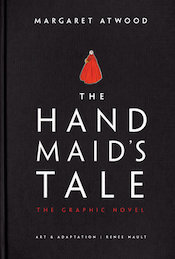Thursday Comics Hangover: The Handmaid's Comic

Are we as a society in danger of The Handmaid's Tale fatigue? Of course not — especially when the adaptations of Margaret Atwood's novel have been so good.
It's true that it's harder to watch Hulu's The Handmaid's Tale TV series, now that a woman's right to choose is more imperiled than at any point in the last 40 years. Fiction is treading dangerously close to the daily headlines in places like Georgia. Influential men promoting a regressive, anti-woman agenda — men like spineless evangelical zealot Mike Pence — are barely trying to conceal their contempt for women anymore.
But again, the show is really good, so we still watch it. And even though we may be nervous about Atwood's The Handmaid's Tale sequel due out this fall, she has earned our trust a thousand times over.
And now, Vancouver BC cartoonist Renée Nault has adapted The Handmaid's Tale into a hardcover graphic novel, and again I approached the endeavor with some nervousness. Does the world really need another adaptation of Atwood's dystopian future, now that we're on our way to making it a dystopian reality?
Turns out, yes we do! Adapting literary classics into comics is unbelievably tricky work, usually resulting in a few staid drawings next to gigantic walls of text. But Nault's adaptation is deft and it reconfigures the book into a new medium while respecting both the original text and the rules of the medium. You don't need to have read the original to read this adaptation. It stands on its own as a very good comic.
Nault's delicate lines form a vocabulary all their own. The handmaids look like gaudy red obelisks — tall and pointy and red as blood in snow. But their faces are whorls and knots of anger and frustration. Nalt clearly brings a manga influence to the book — the characters' eyes are large and expressive, and the panel transitions are less action-to-action-oriented than American comics tend to be. But there are plenty of other influences here, too: I see the pinched Puritanical influence of early American illustrators like John Singleton Copley, for instance. It's a timeless mix of art: the book feels simultaneously like an artifact from both the past and the future.
For legal and artistic reasons, this isn't just an adaptation of the TV show. While the basics of design are the same — the handmaids wear the same basic outfits, obviously — the characters do not resemble their Hollywood counterparts in any way, and the comic hews more closely to the book in several important ways.
But let's be clear: this is great comics. If you agree that the most basic definition of comics is a fluid dance between words and pictures, you will very likely be struck by the beauty of this book. Several sequences like a nearly wordless, dense sequence depicting Offred fleeing to a surreptitious meeting in the city reflect all the tension and claustrophobia of a great noir film, all in a single page. And her use of color is masterful, treating the red of the handmaid habits as a visual signpost guiding the readers through to the visual bloodbath of the book's conclusion, when the color spills out of the lines and drips everywhere.
It's been a long time since I've seen this skilled an adaptation into comics form. (You might notice that I have not mentioned the recent graphic novel adaptation of To Kill a Mockingbird. I assure you that my silence is not an accident.) What Nault has done here is stunning: she has taken a story that has verged on overexposure in recent years, and she has breathed fire into it. This is an adaptation as personal, and as important, as if Nault herself had come up with the story herself.